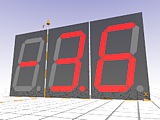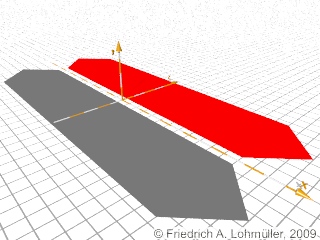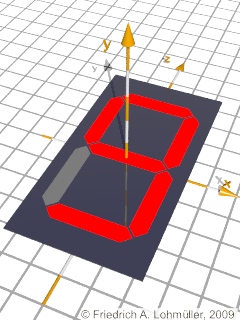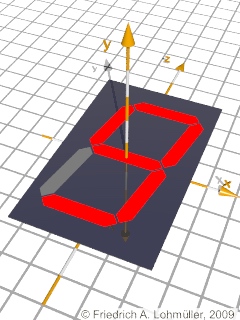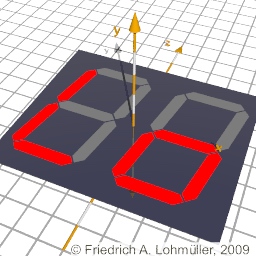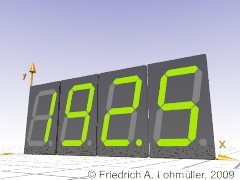Schritt 3: 7-Segment-LED als Makro:
Das folgende Makro verwendet das vorhergehende Makro "SS7_Element(...)"!
//--------------------------------------------
#macro Seven_Segment( SS_Number,
SS_Angle,
SS_Background_Scale,
SS_Light_Color,
SS_Shade_Color,
SS_Background_Color,
) //----------------------
//--------------------------------------------
#local SS_Len = 6.2;
#local D = 0.0001; // just a little bit !!
#local Shear_Factor = tan(radians(SS_Angle));
//---------------------------------------------
// The sequence of the elements:
// - 1
// / / 6 2
// - 7
// / / 5 3
// - 4
//---------------------------------------------
#switch (SS_Number)
#case(0)
#local Lights_On = array [7] {1,1,1,1,1,1,0}
#break
#case(1)
#local Lights_On = array [7] {0,1,1,0,0,0,0}
#break
#case(2)
#local Lights_On = array [7] {1,1,0,1,1,0,1}
#break
#case(3)
#local Lights_On = array [7] {1,1,1,1,0,0,1}
#break
#case(4)
#local Lights_On = array [7] {0,1,1,0,0,1,1}
#break
#case(5)
#local Lights_On = array [7] {1,0,1,1,0,1,1}
#break
#case(6)
#local Lights_On = array [7] {1,0,1,1,1,1,1}
#break
#case(7)
#local Lights_On = array [7] {1,1,1,0,0,0,0}
#break
#case(8)
#local Lights_On = array [7] {1,1,1,1,1,1,1}
#break
#case(9)
#local Lights_On = array [7] {1,1,1,1,0,1,1}
#break
#else // nothing - all off!!!
#local Lights_On = array [7] {0,0,0,0,0,0,0}
#break
#end // end of switch for arrays
//---------------------------------------
#macro Light_Color(Num)
#if(Lights_On[Num] = 1) SS_Light_Color
#else SS_Shade_Color
#end
#end //--------------------- end of macro
union{
union{
object{ S7_Element( Light_Color(1-1))
translate<0,0, SS_Len> }
object{ S7_Element( Light_Color(7-1))
translate<0,0, 0> }
object{ S7_Element( Light_Color(4-1))
translate<0,0,-SS_Len> }
object{ S7_Element( Light_Color(2-1))
rotate<0,90,0>
translate< SS_Len/2,0, SS_Len/2>}
object{ S7_Element( Light_Color(3-1))
rotate<0,90,0>
translate< SS_Len/2,0,-SS_Len/2>}
object{ S7_Element( Light_Color(6-1))
rotate<0,90,0>
translate<-SS_Len/2,0, SS_Len/2>}
object{ S7_Element( Light_Color(5-1))
rotate<0,90,0>
translate<-SS_Len/2,0,-SS_Len/2>}
//*)
} // end LEDs
box{ <-SS_Len/2,-0.01 ,-SS_Len>,
< SS_Len/2,-0.0000001, SS_Len>
scale SS_Background_Scale
texture {SS_Background_Color}}
translate<0,D,0>
} // end of union
#end //---------------------- end of macro
//----------------------------------------
#declare Active_Texture = // red
texture{
pigment{ color rgb< 1,0,0>*1.2}
finish { ambient .9 diffuse .1 phong 1}
} // end of texture
#declare Inactive_Texture = // gray
texture{
pigment{ color rgb<1,1,1>*0.3}
finish { phong 1 reflection 0.00}
} // end of texture
#declare Background_Texture = // ~black
texture{
pigment{ color rgb<1,1,1>*0.05}
finish { phong 1 reflection 0.10}
} // end of texture
//----------------------------------------
//----------------------------------------
object{
Seven_Segment(
9, // 0~9, integer !!! SS_Number,
0, // 0~10, SS_Angle for shearing,
< 1.5, 10, 1.40>, // SS_Background_Scale,
// < 1.70, 10, 1.40>, //for SS_Angle=10
Active_Texture, // SS_Light_Color,
Inactive_Texture, //SS_Shade_Color,
Background_Texture, //SS_Background_Color,
) //------------------------------------
scale 0.1
rotate< 0,0,0>
translate<0,0.05,0> }
//----------------------------------------
|
7-Segment LCD
Zusatz-Schritt:
Geschertes 7-Segment-LCD.
Wenn wir bei der Marke "//*)" zu unserem Makro eine
Scherungs-Matrix hinzufügen:
matrix< 1, 0, 0, // matrix-shear_z_to_x
0, 1, 0,
Shear_Factor, 0, 1,
0, 0, 0 >
dann müssen wir das Hintergrund-Panel durch
entsprechendes Skalieren anpassen:
< 1.70, 10, 1.40>
Eine gescherte 7-Segment LCD Anzeige.
Sicher können sie nun das gegenwärtige LCD dahingehend erweitern, dass es in der Lage ist
auch einige wichtige nicht- numerische Zeichen darzustellen:
Ein Lo-7-Segment LCD. :-)
Und jetzt ist es an Ihnen ein Display mit mehreren Stellen und perfekter als dieses zu entwickeln:
Ein 7-Segment LCD
mit 4 Stellen und Dezimalpunkt.
|
